NASCAR Faces Massive Million-Dollar Losses: NASCAR President Steve Phelps has recently highlighted the notable financial repercussions stemming from the LA Clash, admitting to “millions and millions of dollars” in losses. This event, designed to captivate a broader audience and modernize the NASCAR brand, highlights the inherent challenges of urban racing initiatives. Phelps’s reflections raise critical questions about the sustainability of such ventures and the strategies NASCAR must implement moving forward. As the organization grapples with this setback, the implications for its future operations and fan engagement strategies become increasingly pertinent. What lessons will emerge from this experience?
Key Highlights
- NASCAR President Steve Phelps revealed that The Clash at LA Coliseum resulted in “millions and millions of dollars” in financial losses.
- The event aimed to attract a diverse audience but ultimately faced significant economic challenges, prompting its exclusion from the 2025 schedule.
- Phelps emphasized the need for tactical venue selection and fiscal sustainability in future urban racing events to avoid similar pitfalls.
- The transparency about financial setbacks reflects NASCAR’s commitment to addressing challenges and reshaping its long-term strategy.
- Future plans focus on enhancing fan engagement through creative strategies and sustainability initiatives to build a loyal, diverse fan base.
Overview of The Clash at LA Coliseum
The Clash at the LA Coliseum, a unique spectacle in the NASCAR calendar, has served as a bold experiment in expanding the sport’s reach beyond traditional venues. For the past three years, this iconic stadium has hosted the opening event of the NASCAR Cup Series, showcasing the organization’s willingness to innovate and adapt in a rapidly changing sports landscape. By racing within the confines of the historic Coliseum, NASCAR aimed to capture the attention of a diverse audience in one of America’s largest markets.
This initiative was not without its challenges. While the event showed NASCAR’s versatility in racing anywhere and everywhere, it also highlighted considerable financial implications. The decision to race in Los Angeles was rooted in a desire to attract new fans and generate revenue; however, the reality of the financial outcomes revealed a different narrative.
As the organization turns the page on this experiment, it is remarkable that Los Angeles will not be featured in the schedule for 2025, suggesting an acknowledgment of the economic shortcomings associated with the venue.
The Clash at the LA Coliseum has provided valuable insights into NASCAR’s potential for expansion, but it has also emphasized the importance of tactical venue selection. Moving forward, NASCAR must carefully evaluate its approach to urban racing events, balancing the allure of new markets against the necessity of fiscal sustainability.
NASCAR President Steve Phelps on The Clash
NASCAR President Steve Phelps recently addressed the complexities surrounding The Clash during an episode of Kevin Harvick’s Happy Hour podcast, shedding light on the considerable financial losses incurred by the event.
While acknowledging a staggering loss of “millions and millions of dollars,” Phelps emphasized the tactical importance of The Clash for NASCAR and its partners, particularly FOX. He articulated a vision for the event that transcended traditional metrics of success.
“I think so. … There are things that you need to do to scale it, right? So there are costs associated with that we have to [analyze] over time. Because we lost millions and millions of dollars on The Clash. But it was an important thing to do. It was important for our friends at FOX, I think it was important to kick off the season the right way.”
“It was unique, it was different, it allowed people to think differently about the sport. And when I talk about that, I’m not talking about people who are in the sport or stakeholders or longtime fans.” – Phelps
Phelps outlined three key objectives that guided the decision to go forward with The Clash, despite its financial pitfalls:
- Innovation and Uniqueness: The Clash served as a unique kickoff for the season, challenging conventional perceptions of NASCAR and enticing a broader audience.
- Broadening the Fan Base: The event aimed to engage casual fans and those unfamiliar with NASCAR, leveraging recent initiatives like Netflix shows to attract a diverse demographic.
- Cultural Relevance: By introducing elements like Bowman Gray, NASCAR sought to connect with new fans, showcasing the sport’s rich history and vibrant culture.
Phelps asserted that while the losses were substantial, the long-term vision of expanding NASCAR’s reach and invigorating its brand was paramount.
The Clash was a calculated risk, intended to ignite interest and fundamentally reshape how the sport is perceived, particularly among those on the fringes of NASCAR fandom.
Kevin Harvick’s Show and Steve Phelps’ Honesty
Kevin Harvick’s podcast has emerged as a platform for candid discussions about the challenges and triumphs within the NASCAR community. In a recent episode, Harvick explored the ramifications of the LA Clash, a race that has stirred considerable controversy, not only for its operational complexities but also for the substantial financial losses it incurred.
Harvick’s ability to engage in these dialogues highlights the importance of transparency in motorsports, especially when discussing the economic stakes involved.
Steve Phelps the President of NASCAR, provides a notable case study in this regard. His willingness to confront the financial fallout from the Clash demonstrates a commendable level of honesty and accountability.
In an industry often characterized by bravado and competitive secrecy, Phelps’s admission of the event’s monetary shortcomings is invigorating. He emphasizes the reality that considerable investments do not always yield the anticipated returns, a truth that resonates deeply within a sport that thrives on unpredictability.
Moreover, Phelps’s insights during Harvick’s show reveal a tactical perspective on how NASCAR intends to address these challenges moving forward. His acknowledgment of the losses is not merely an admission of failure; it serves as a catalyst for future improvements and innovation within the sport.
Long-Term Investment and Future Outlook
Investing in the future of motorsports demands a tactical vision that balances immediate challenges with long-term growth potential. NASCAR’s commitment to nurturing its fanbase—both new and existing—illustrates a calculated pivot aimed at revitalizing interest in the sport. The recent trials, particularly the LA Clash debacle, serve as pivotal moments that could shape the course of the organization.
“It’s those that are on the fringe or would not consider NASCAR to be part of their subset of sport. And I think that’s an important thing for us.”
“So the converse is going to happen with a Bowman Gray, which is, you are going to get causal fans that we have now brought to the fold with a lot of the different things that we’ve done, Netflix shows and different pieces, where you have this massive new fanbase that’s here, and they’re going to look at this historical, crazy things at the Madhouse and the documentary and the whole thing and they’re going to be like ‘Wow, this is insanity.’ And I think that’s a good thing, I do.” – Phelps
To guarantee a sustainable future, NASCAR must focus on the following calculated areas:
- Fan Engagement: Implement creative strategies to attract younger audiences while retaining loyal fans. This includes leveraging social media platforms and interactive experiences that resonate with diverse demographics.
- Event Creativity: Expand beyond traditional race formats to include varied experiences, enhancing the entertainment quotient. Events that incorporate music, culture, and technology can draw in broader crowds and heighten the spectator experience.
- Sustainability Initiatives: Investing in eco-friendly practices and technology can appeal to environmentally conscious fans and create a modern image for NASCAR, aligning it with global sustainability trends.
While the path forward may be fraught with uncertainty, NASCAR’s proactive approach to fan engagement, event creativity, and sustainability can potentially transform the landscape.
The effectiveness of these initiatives will ultimately determine if NASCAR can convert new fans into lifelong supporters, reinforcing its position in the competitive sports arena. Only time will reveal whether these long-term investments will yield the anticipated rewards.
News in Brief: NASCAR Faces Massive Million-Dollar Losses
The financial losses incurred during the LA Clash highlight the inherent challenges of urban racing initiatives within NASCAR. Steve Phelps’ candid acknowledgment of these setbacks reflects a commitment to learning from adversity and stresses the necessity for tactical long-term planning. By prioritizing fan engagement and adapting to evolving market dynamics, NASCAR can work towards rebuilding its image and ensuring sustainable growth in the future, ultimately transforming challenges into opportunities for innovation and revitalization within the sport.
ALSO READ: NASCAR Returns to Lime Rock After 14 Years – Truck Series Set for Epic Comeback



